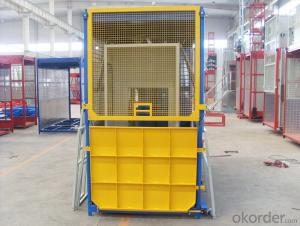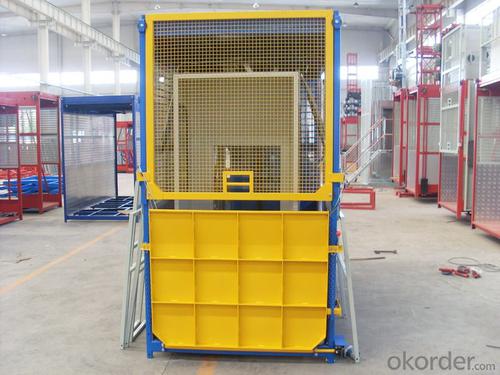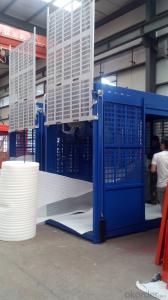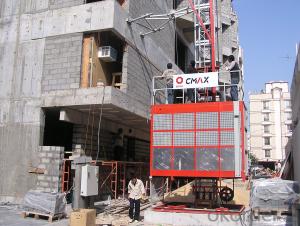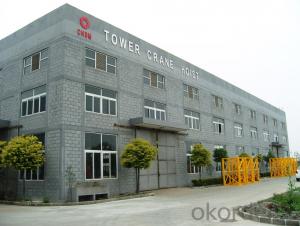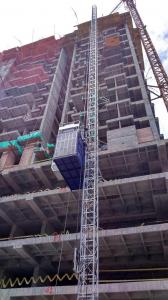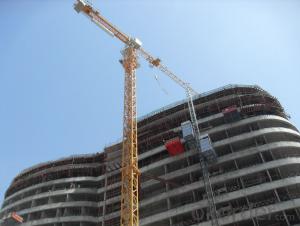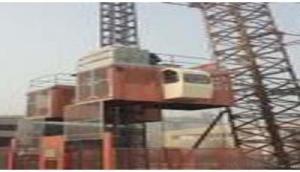Construction Elevator Building Hoist Lift Building Hoist with CE SC200/200
- Loading Port:
- Shanghai
- Payment Terms:
- TT OR LC
- Min Order Qty:
- 1 unit
- Supply Capability:
- 1000 unit/month
OKorder Service Pledge
OKorder Financial Service
You Might Also Like
Specification
Construction Elevator Building Hoist Lift Building Hoist with CE SC200/200
We are special supplier of building hoist in China, our building hoist have been Widely exported to all over the world and won good reputation, whose payload capacity is as much as 10000kg, lifting speed can reach up to 96m/min, and the erection height reaches up to 550m., our products have been widely used for transportation for both men and cargo in field of general buildings, but also industry, electric power, mining well, oil, chemical industry etc.
SC270TD, SC270/270TD building hoist:
1). Each cage load capacity: 2700kg
2). Lifting speed: 36m/min, or 0∼ 63m/min, or 0∼ 96m/min
3). Mast section: Paint or hot dipping zinc
4). Cage: Single cage or twin cage
5). Recommended cage inner dimension(LxWxH)(m): 2.5x1.3 x2.5; 3.0x1.3x2.5; 3.2x1.5x2.5; 3.6x1.5x2.5; 3.8x1.5x2.5; 4.0x1.5x2.5; 4.2x1.5x2.5, cage dimension is according to requirement of customer and special project.
6). Motor and reducing device: Made in China, can be SEW Germany according to requirements.
7). Counterweight: With counterweight or without counterweight
8). The colors of cage: Yellow, or red, or blue
9). Other each cage load capacity for your to choose: 1000kg, 2000kg, 2700kg, or 3200kg
| Type | Payload kg | Lifting speed m/min | Motor power kW | Inverter power kW | Counter Weight kg | ||
| Low speed | Single cage no counterweight | SC200GD | 2000 | 0~46 | 3×15 | 45 | 0 |
| SC270GD | 2700 | 0~46 | 3×18.5 | 55 | 0 | ||
| SC320GD | 3200 | 0~46 | 3×22 | 75 | 0 | ||
| Twin cage no counterweight | SC200/200GD | 2×2000 | 0~46 | 2×3×15 | 2×45 | 0 | |
| SC270/270GD | 2×2700 | 0~46 | 2×3×18.5 | 2×55 | 0 | ||
| SC320/320GD | 2×3200 | 0~46 | 2×3×22 | 2×75 | 0 | ||
| Middle speed | Single cage no counterweight | SC120GZ | 1200 | 0~63 | 3×15 | 45 | 0 |
| SC200GZ | 2000 | 0~63 | 3×18.5 | 55 | 0 | ||
| Single cage with counterweight | SCD200GZ | 2000 | 0~63 | 2×15 | 30 | 2000 | |
| SCD270GZ | 2700 | 0~63 | 2×18.5 | 37 | 2000 | ||
| SCD320GZ | 3200 | 0~63 | 3×15 | 45 | 2000 | ||
| Twin cage no counterweight | SC120/120GZ | 2×1200 | 0~63 | 2×3×15 | 2×45 | 0 | |
| SC200/200GZ | 2×2000 | 0~63 | 2×3×18.5 | 2×55 | 0 | ||
| Twin cage with counterweight | SCD200/200GZ | 2×2000 | 0~63 | 2×15 | 2×30 | 2×2000 | |
| SCD270/270GZ | 2×2700 | 0~63 | 2×18.5 | 2×37 | 2×2000 | ||
| SCD320/320GZ | 2×3200 | 0~63 | 2×3×15 | 2×45 | 2×2000 | ||
| High speed | Single cage no counterweight | SC100GS | 1000 | 0~96 | 3×22 | 75 | 0 |
| SC120GS | 1200 | 0~96 | 3×22 | 75 | 0 | ||
| SC200G | 2000 | 0~96 | 3×22 | 90 | 0 | ||
| SC200GS | 2000 | 0~96 | 3×22 | 90 | 0 | ||
| Single cage with counterweight | SCD200G | 2000 | 0~96 | 3×15 | 45 | 2000 | |
| SCD200GS | 2000 | 0~96 | 2×22 | 45 | 2000 | ||
| SCD270G | 2700 | 0~96 | 3×18.5 | 55 | 2000 | ||
| SCD320GS | 3200 | 0~96 | 3×22 | 75 | 2000 | ||
| Twin cage no counterweight | SC100/100GS | 2×1000 | 0~96 | 2×3×22 | 2×75 | 0 | |
| SC120/120GS/ | 2×1200 | 0~96 | 2×3×22 | 2×75 | 0 | ||
| SC200/200G | 2×2000 | 0~96 | 2×3×22 | 2×90 | 0 | ||
| SC200/200GS | 2×2000 | 0~96 | 2×3×22 | 2×90 | 0 | ||
| Twin cage with counterweight | SCD200/200G | 2×2000 | 0~96 | 2×3×15 | 2×45 | 2×2000 | |
| SCD200/200GS | 2×2000 | 0~96 | 2×2×22 | 2×45 | 2×2000 | ||
| SCD270/270G | 2×2700 | 0~96 | 2×3×18.5 | 2×55 | 2×2000 | ||
| SCD320/320G | 2×3200 | 0~96 | 2×3×22 | 2×75 | 2×2000 | ||
| SCD320/320GS | 2×3200 | 0~96 | 2×3×22 | 2×75 | 2×2000 | ||
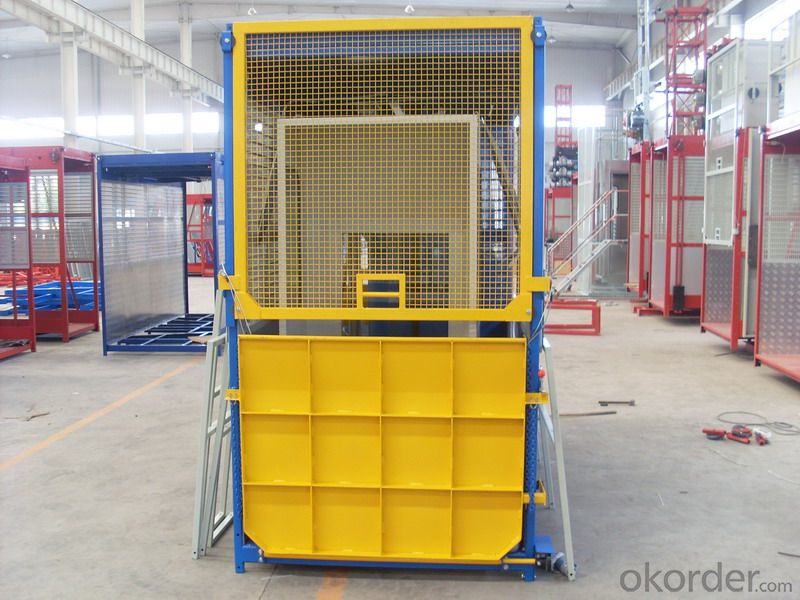
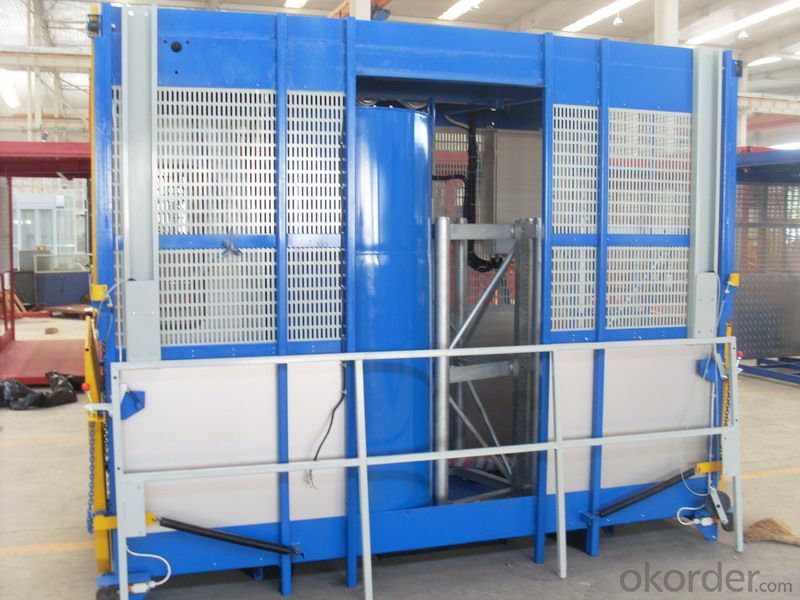
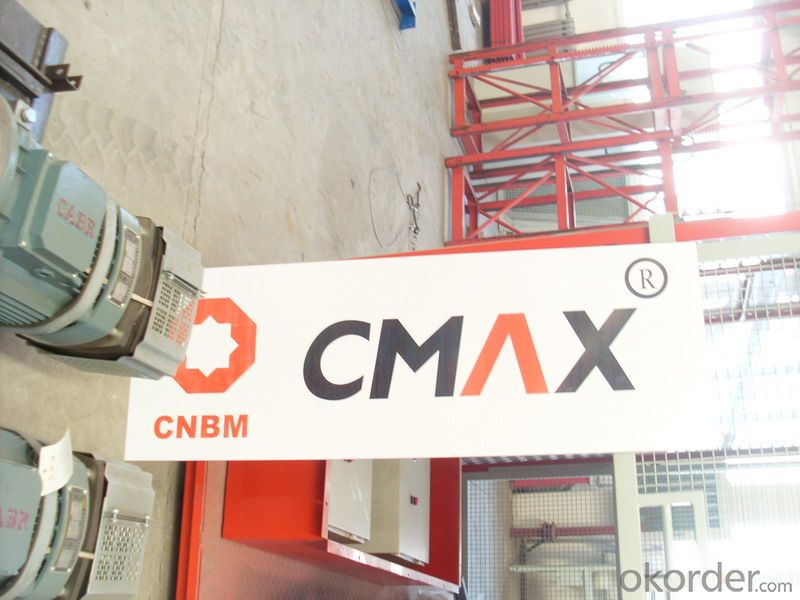
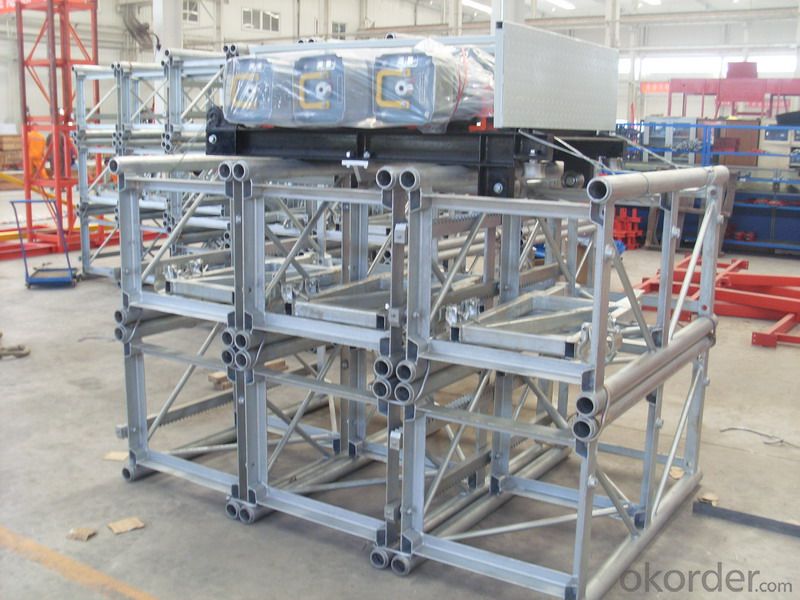
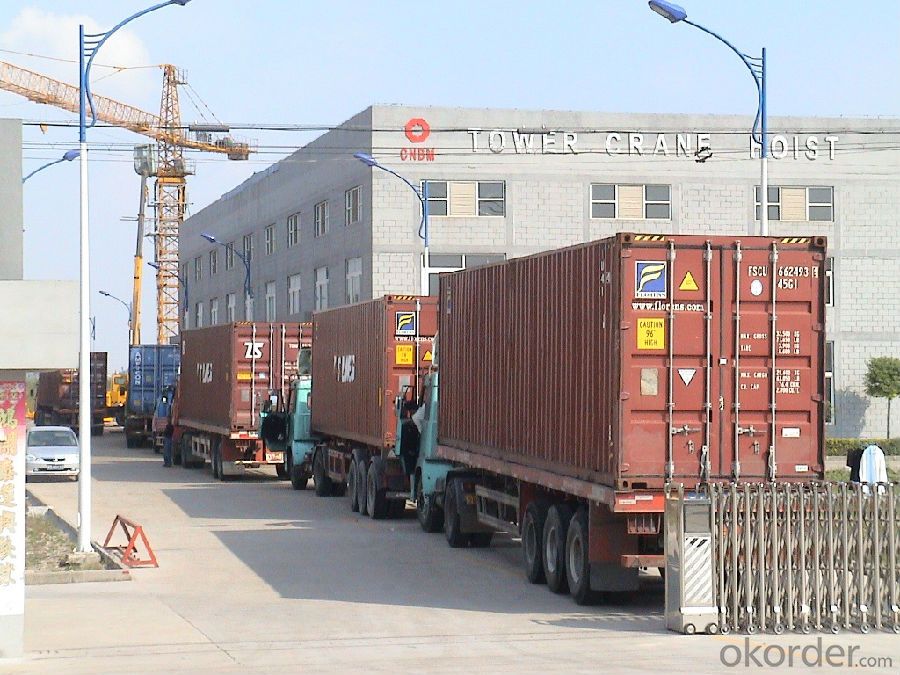
- Q: This question asks about the regular maintenance tasks needed to keep hydraulic pumps in building hoists functioning properly.
- <p>Maintenance requirements for hydraulic pumps in building hoists include regular inspection of the pump for leaks, wear, and proper lubrication. It's crucial to check the hydraulic oil level and quality, ensuring it's clean and at the correct level. The oil should be changed periodically as per the manufacturer's recommendations. Inspect the pump for any unusual noises or vibrations which could indicate wear or damage. Regularly clean the filter to prevent blockages and ensure efficient operation. Additionally, check the pump's pressure and flow rate to confirm it's operating within the specified parameters. Following the manufacturer's maintenance schedule and guidelines is essential to prolong the life of the hydraulic pump and ensure the safety and efficiency of the building hoist.</p>
- Q: This question asks about the measures to ensure that safety belts on a building hoist are correctly installed and utilized.
- <p>To ensure that safety belts on a building hoist are properly installed and used, follow these steps: 1. Regularly inspect the belts for any signs of wear, damage, or corrosion. 2. Ensure that the belts are securely fastened and properly adjusted according to the manufacturer's guidelines. 3. Conduct a thorough pre-use inspection before each operation to confirm that the belts are in good condition and functioning correctly. 4. Train all personnel on the proper use of safety belts and the importance of wearing them at all times while operating the hoist. 5. Implement a maintenance schedule to regularly check, clean, and lubricate the belts to prolong their lifespan and ensure optimal performance. 6. Replace any damaged belts immediately to prevent accidents and ensure the safety of workers.</p>
- Q: A building hoist is a mechanical device used in construction to lift materials and sometimes workers vertically. It is essential for the efficient movement of materials in high-rise construction.
- <p>The function of a building hoist is to facilitate the vertical transportation of materials, equipment, and sometimes workers within a construction site. It is particularly useful in high-rise buildings where manual lifting would be inefficient and unsafe. A building hoist allows for the rapid and safe movement of materials, reducing labor costs and improving construction speed.</p>
- Q: This question asks for measures to protect lifting equipment from damage during its operation.
- <p>To prevent damage to lifting equipment during operation, ensure regular maintenance and inspection are conducted to check for wear and tear. Adhere to the equipment's load limits and never exceed them. Use appropriate lifting techniques and ensure the load is balanced. Keep the equipment clean and free from debris. Train operators thoroughly on safe operating procedures. Avoid sudden starts or stops, and ensure all safety features and guards are in place and functioning correctly. Regularly check cables, hooks, and other critical components for any signs of damage. Always follow the manufacturer's guidelines and industry safety standards.</p>
- Q: Is it possible to use a lifting device to assist in lifting a person who is too heavy to lift manually?
- <p>Yes, lifting devices such as hoists or mechanical lifts can be used to safely lift someone who is too heavy to lift manually. These devices are designed to support the weight and reduce the risk of injury to both the person being lifted and the caregiver. It's important to use the appropriate equipment for the individual's weight and to follow safety guidelines and manufacturer's instructions to ensure proper and secure lifting.</p>
- Q: The user is asking if it's possible to use a building hoist, typically used for construction, to lift a car.
- <p>Using a building hoist to lift a car is not recommended. Building hoists are designed for lifting materials and equipment in construction settings, not for vehicles. They may not have the appropriate safety features or load-bearing capacity for a car. Attempting to lift a car with a building hoist could result in damage to the car, the hoist, or even personal injury. For lifting a car, it's best to use a vehicle-specific lift or a hydraulic lift designed for such purposes, ensuring safety and proper support.</p>
- Q: Is it possible to utilize a building hoist to lift objects with varying dimensions and weights?
- <p>Yes, building hoists are designed to lift a variety of objects with different sizes and weights. However, each hoist has specific weight and size limitations that must be adhered to for safety and operational reasons. It's crucial to ensure that the objects being lifted are within the hoist's capacity to prevent accidents and damage. Always consult the manufacturer's specifications and safety guidelines before using a hoist for lifting operations.</p>
- Q: Construction site construction elevator and tower crane, which unit security check and acceptance?
- The inspection, inspection, inspection and acceptance of the inspection station shall not be put into operation
- Q: This question asks about the safety mechanisms or features that are included in a hydraulic building hoist to ensure its secure operation.
- <p>Hydraulic building hoists are equipped with several safety features to ensure secure operation. These include overload protection to prevent the hoist from lifting more weight than it is designed for, emergency stop buttons for immediate cessation of operations, safety hooks or shackles to secure the load, and lower limit switches to prevent over-lowering. Additionally, they often have a fail-safe valve system that locks the hoist in place if pressure is lost, and a cage or gate to protect operators from falling objects. Regular maintenance and inspection are also crucial for maintaining the safety of these hoists.</p>
- Q: What is the purpose of a building hoist and can it be utilized for lifting heavy objects that cannot be manually lifted?
- <p>Yes, building hoists are specifically designed to lift heavy objects that are beyond the capacity of manual lifting. They are essential in construction sites for moving materials such as bricks, cement, and steel beams to various levels of a building. Building hoists are engineered to handle significant weight and ensure the safe and efficient transport of materials, reducing the risk of injury and improving productivity on construction sites.</p>
Send your message to us
Construction Elevator Building Hoist Lift Building Hoist with CE SC200/200
- Loading Port:
- Shanghai
- Payment Terms:
- TT OR LC
- Min Order Qty:
- 1 unit
- Supply Capability:
- 1000 unit/month
OKorder Service Pledge
OKorder Financial Service
Similar products
Hot products
Hot Searches
Related keywords
